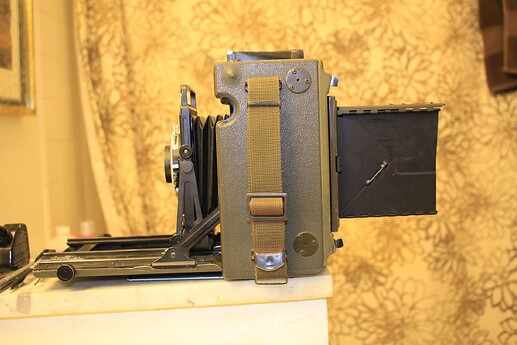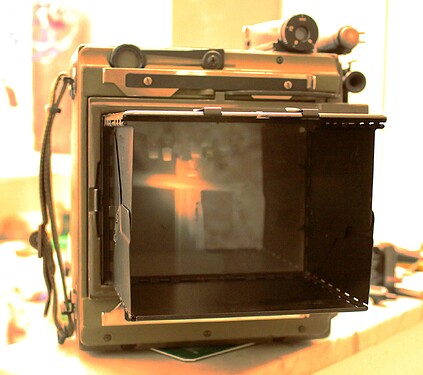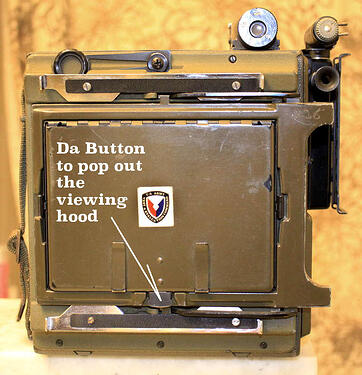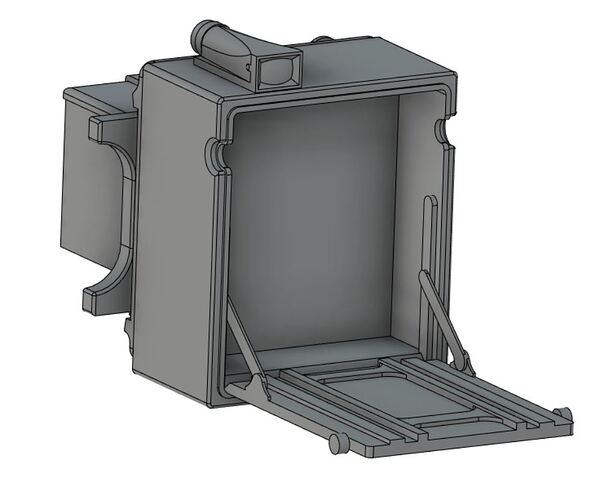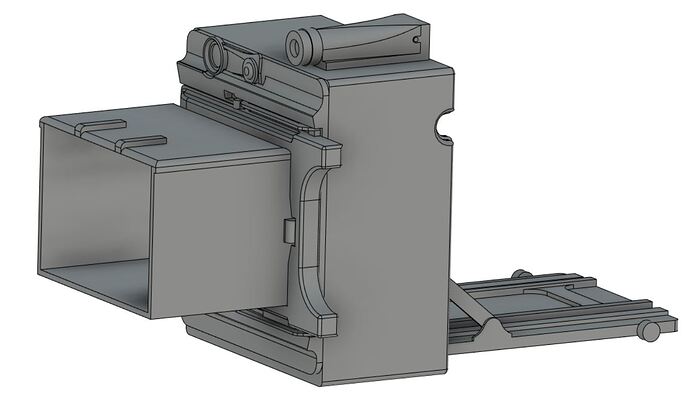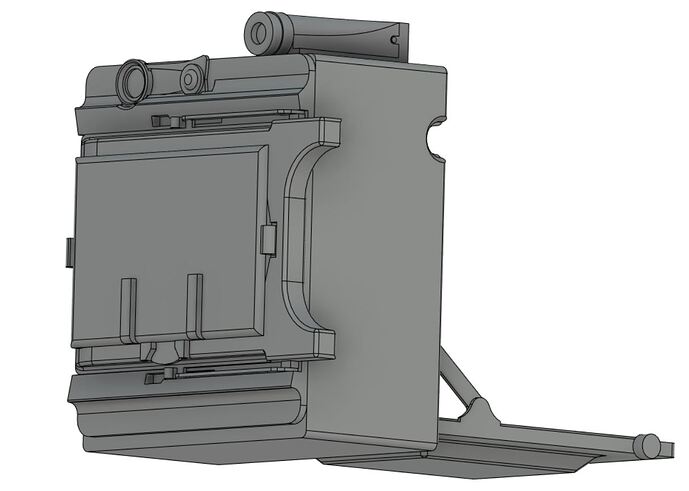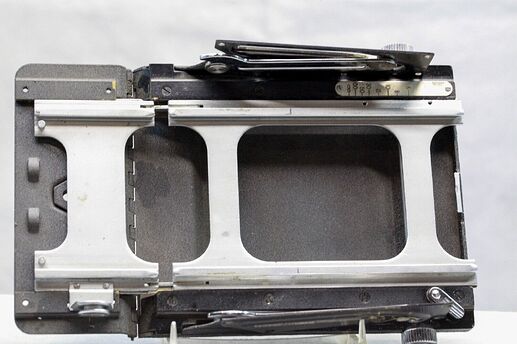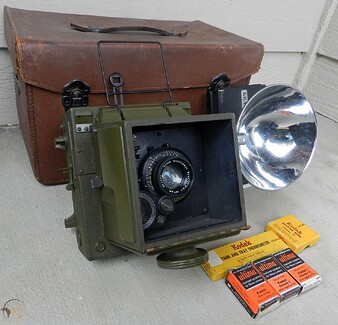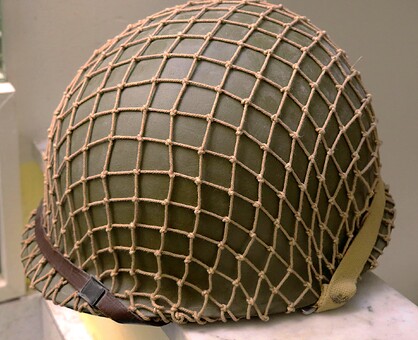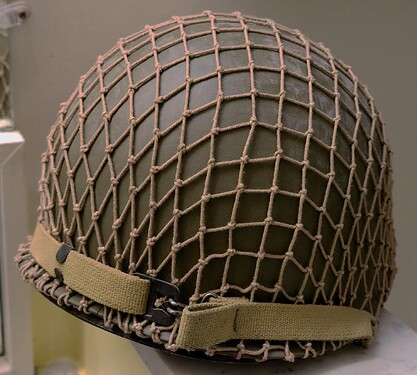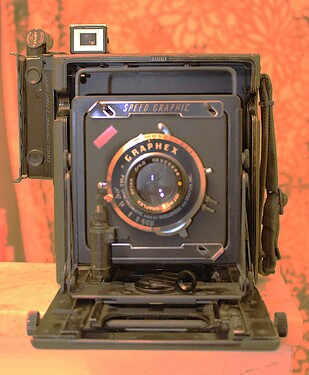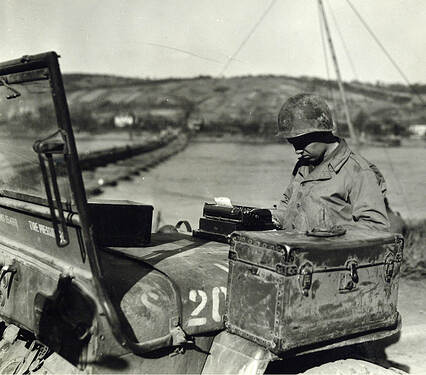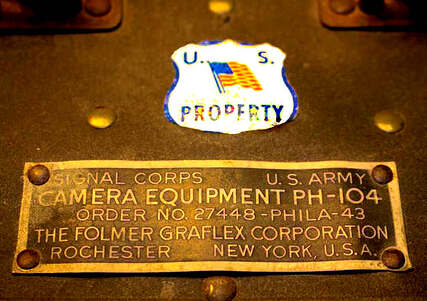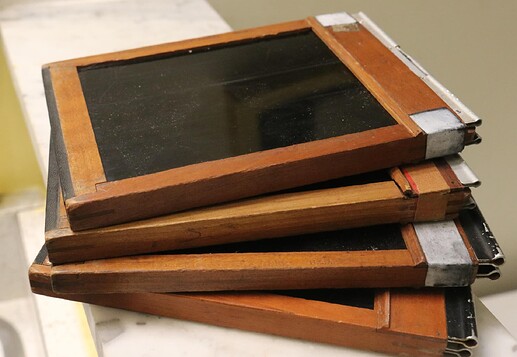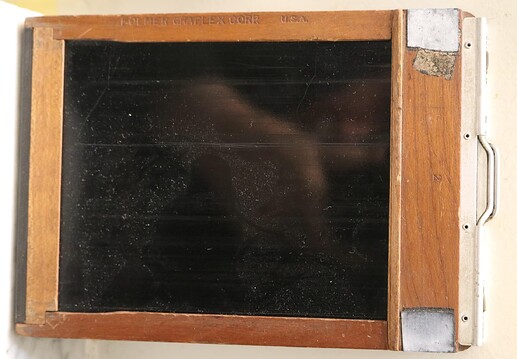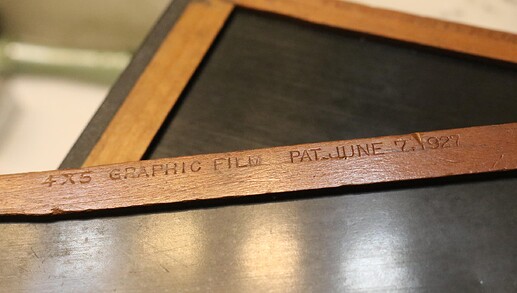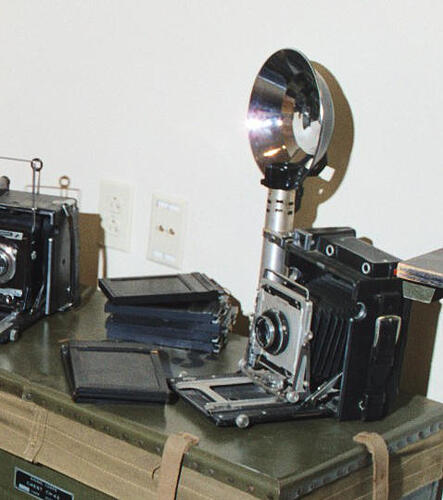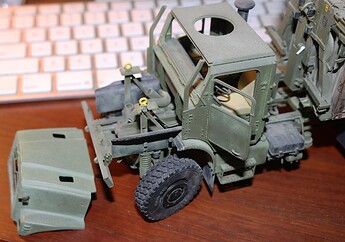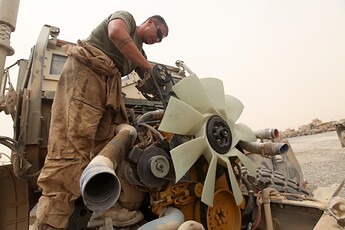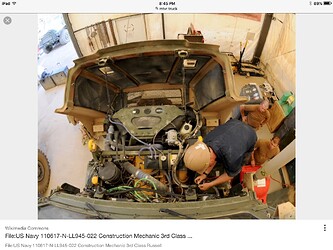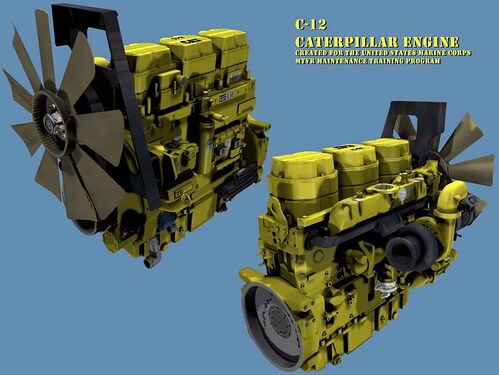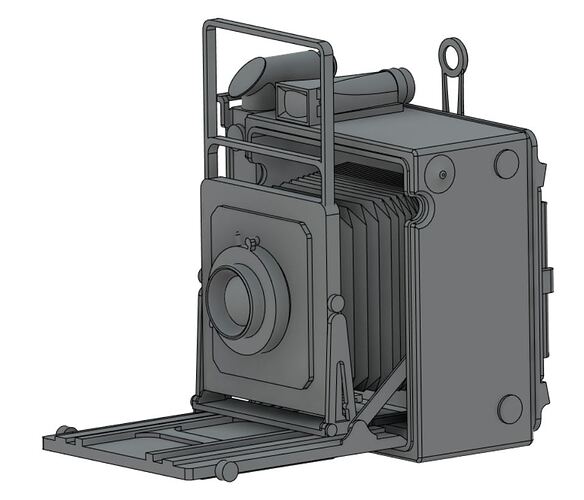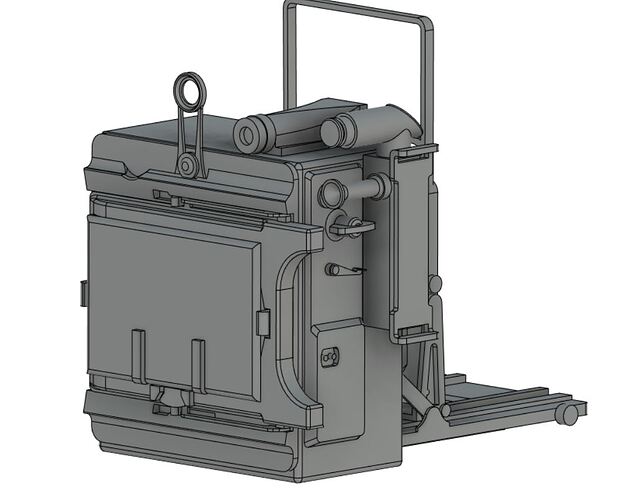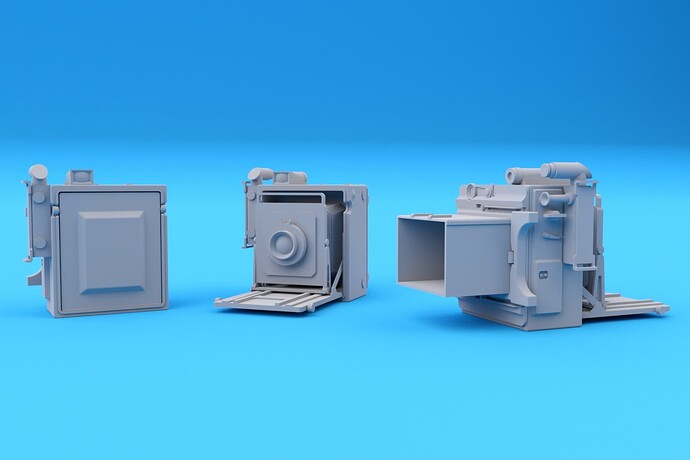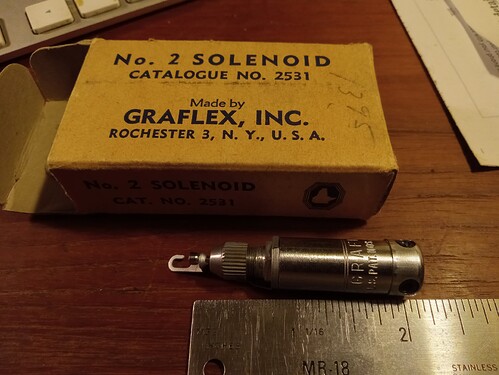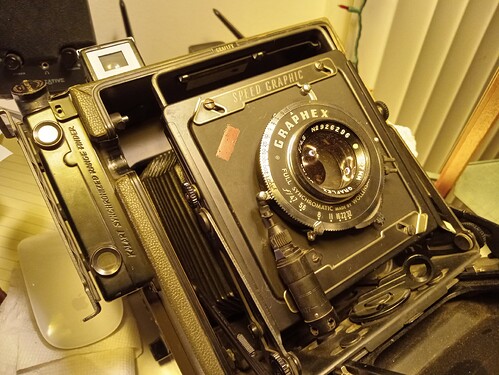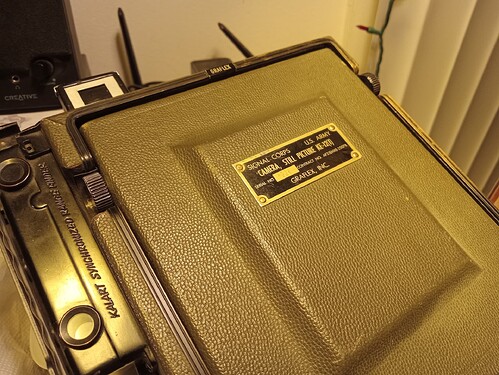And here is (perhaps) another interesting capability of the “Graflex” Cameras:
They could be used as a straight out-and-out studio view camera (like the Rembrandt) for doing portrait and assorted other industrial/commercial/military photography.
Just push one button and out pops the spring loaded rear viewing hood. (Present on both the “Graflex” and the “Speed Graphic” Cameras.)
You could then focus directly on the ground glass just like any other studio view camera.
Note to Mike G.:
Do not worry about those chrome spring loaded clips above and below the viewing hood. They WERE NOT on the regular GI Graflex and constitute what is known as the “Graf-Loc” back.
I believe they were either late war or post-war. These would allow me to put a 120/220 roll film back on the camera or even a 100 foot motorized long roll magazine for taking hundreds of ID shots (or senior high portraits) in a day’s time. Which I did for four years!
This Army/Air Force camera of mine did not come with the Graf-Loc back but I changed it out on this camera body to give myself more functionality.
But not to worry I have all the original parts that I will one day sell with the camera when the day finally comes. Remember my comment about parts interchangeability? It was only a six screw change-out.
Da Button to Pop Out the Viewing Hood:
Again present on both the GI Graflex and the Speed Graphic.
The cover was tightly spring loaded and one touch of this button and it was fairly much an instant “presto - change-O” operation. You could use it to make people jump as a bad joke if you wanted to.
And mine is still working fine 60-70 years later.
2 Likes
That’s actually something I was wondering about. Does the Graf-Loc also include the two horizontal latches just above and below the black bars on the Graf-Loc mechanism?
The two black bars, the four screws and the chrome lip locks WOULD NOT be there on a non- Graf-Loc back.
However the rest of the camera back would be exactly as you have drawn it, except for the missing viewing hood release button.

OK a bit more work done on the Graflex. Interior of the light box/bellows is going to be inaccurate but I can’t find very many detailed pictures of that area and it won’t be seen regardless. Already, the support leg is 0.5mm thick. It’ll print, I’m just not sure how well.
I also printed 2 HCU-45 pallets and 2 wood 48"x40" pallets. I just haven’t gotten a chance to take a look at them. I’d been struggling to scan a backpack of mine for nearly 4 hours. Now officially a tomorrow-after-work project.
4 Likes
For now the closest thing I have found to prove that Army Photographers used Speed Graphics in the field.
Caption says Pacific Theater and nothing else.
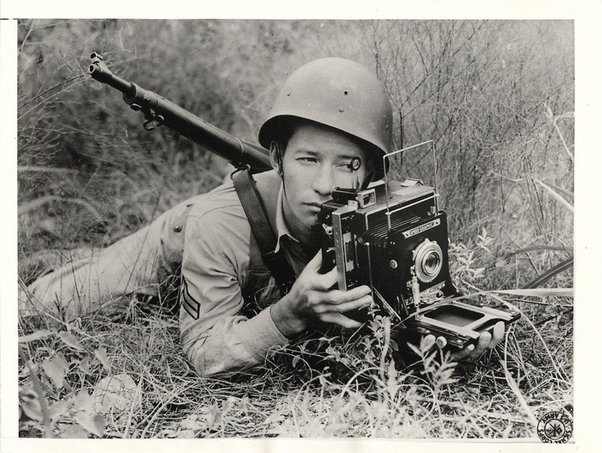
Notice this guy’s use of the pop-up “Sports Finder.”
1 Like
Need to lower the floor in your camera box interior. Focusing rails should go all the way back to the rear wall under the bellows with a hinge in them at the appropriate place.
I love the sort of 60s console TV screen look you have given to the front of that top viewfinder. In reality the front of that is just a flat pane of optical glass.
(Now if you broke that glass to look inside what you WOULD see is exactly what you are showing there. However covered by the glass the inner optics are just barely visible.) It is however a very nice piece of CAD work you have done there and it DOES make the camera look more detailed and interesting - so your call.
Here is what those focusing rails look like dissembled with just the bottom plate of the camera box and the front door still attached.
< The back of the camera is to the left.<
eBay Photo
I admit I may be pushing for a level of accuracy that is totally wasted on such a small item, especially when it will, in the end be painted mostly black.
3 Likes
Graflex also made a more durable version of their Speed Graphic camera as shown here. It has a totally fixed body with no bellows. A lid swings up from below the lens housing to totally cover the front of the camera when not in use. (More rare than other style camera.)
It was not as flexible as the regular camera and focusing was by a different method.
I have heard this referred to as the camera for the Pacific Theater but Rosenthal was still using his regular Graflex on Iwo - but then he was an AP photographer and not a Military one???
Recent work on the Graflex.
1 Like
I can definitely scan it if you can send it my way. The scan itself would probably only take a day or two including scans, rescans, and processing. The seam on the back won’t matter very much, it won’t show up in a print.
1 Like
Reference as to front of camera.
Sorry about the soft focus here.
Note the shinny mask inserted into that top viewfinder.
Graflex had all sorts of insert masks to represent different telephoto lens focal lengths.
In this particular case I am using the Graf-Loc back to allow me to attach a 120/220 roll film back. (Using the smaller film size requires a choke mask to remind me NOT to assume to use the entire image I might otherwise see in the viewfinder.)
Sorry to try and make more work for you but . . . .
. . . you are sort of asking for it here!
Graflex PH-104 Vulcanoid carry case for the Speed Graphic. (Same case is used for all Graflex 4x5 cameras of similar design.)
Civilian case is gray. Military case is Olive Drab.
My 104 case:
*(Handle should be black Bakelite. I had to repair mine.)
Halloran’s 104 case:
- Length: 19 3/8 inches
- Width: 9 inches
- Height: 11 1/8 inches
- Depth of lip on lid: 3 1/4 inches
- Handle Width: 5 1/4 inches. (Width does not include hinges)
US Property badge is most probably post-war.
1 Like
And then there are those film holders:
Wartime film holders would be black bakelite or plastic.
(I came across these much older - but still perfectly usable - wooden ones by Graflex and I then donated all my black plastic ones to a fellow photographer. - Sorry)
The design for either is basically the same.
Four film holders equal eight shots:
Holder with dark slide inserted:
Holder with dark slide removed:
Embossed Patent Date June 7, 1927:
And yes you can learn to load and unload these holders in total darkness, either in a make shift darkroom (tent or closet) or using a light tight changing bag.
Changing Bag: - Imagine a double layered, very opaque, black, long sleeve T-shirt with no neck opening. Across the waist band there are double zippers.
You place your film holders inside the bag along with a empty Kodak Film Box.
You then close both zippers and insert your arms into the very tight elastic sleeves and unload your exposed film from the day’s shooting, placing it in the Kodak box. Close the box.
Now repeat this process, in reverse for loading fresh film into the holders for your tomorrow’s shoot.)
1 Like
The black film holders before I gave them away.
2 Likes
Sorry for this post, but every time I see one of those Graflex Light Guns…
Sorry.
1 Like
I understand completely. There is even a company out there that have bought the rights to the name so they can manufacture exact reproduction flash units AND light sabres.
That’s where I got this one; it’s called “The Graflex Shop”. They have reproduction light guns that can be converted to a lightsaber or built into a fully functional light gun.
Graflex 3 Cell Flash - Graflex Inc – The Graflex Shop
1 Like
As I was just saying . . . . Over on the Scratch Built & Conversions Thread:
Those Mk23 Marine Corps Cargo Trucks Could Sure Use a Resin, or Plastic or 3D Printed engine!
That one piece fiberglass hood,
(cover, bonnet ~ whatever) though not currently hinged, would be easily posed if only we had a
(whimper, whimper, wine, wine) CAT C-12 engine to show off under it.
(If someone is already offering it I certainly missed it!)
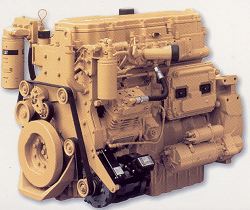

3 Likes
Except for the flash, the Graflex is finished.
5 Likes
This work looks fantastic! Cannot wait to get my hands on these!
Again, I will be your first customer - count on it!
Some slight comments if I might, but I don’t think they are anything major.
- The lens board which is now a raised surface if you would instead sink that in.
- Add two small lens depressions to the two “eyes” on the front of the rangefinder.
- Add the hint of the brass registration name plate riveted to the outside front cover of the camera. Size: 2 1/4" x 1"
- Consider adding the solenoid to the front of the lens assembly as this was a quite common accessory.
Oh, and do you want to try for the canvas hand grip or leave that up to the modeler’s discretion?
That name plate is 2 1/4 x 1 inch
Also please note the two inset lenses of the rangerfinder.
1 Like
